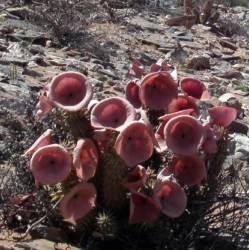Hoodia gordonii
Hoodia gordonii (Masson) Sweet ex Decne.
Family: Apocynaceae
Common names: bitter ghaap (Eng.); bitterghaap, muishondghaap, wolweghaap, bobbejaanghaap, bergghaap, bokhorings (Afr.); khobab (Khoi)
Introduction
Hoodia gordonii is one of the most sought after succulents due to its medicinal properties. It has been called one of the wonder plants of the twenty-first century. Trade in this plant is restricted. See Information document on trade in Hoodia gordonii and other Hoodia species for further details.

Description
Description
Hoodia gordonii is a spiny succulent. In the early stages only one stem is produced but at a later stage the plant starts branching. Mature plants can have as many as 50 individual branches and weigh as much as 30 kg. Plants under ideal conditions can attain a height of 1 m. Flowers are borne on or near the terminal apex (top part of the plant). The flowers are large and have a carrion-like smell (smell similar to rotten meat). In some ways the Hoodia flowers resemble a petunia flower. Flowers vary in colour from pale straw to dark maroon. Flowers are normally borne in early spring (August or September). Flowers can reach a diameter of 75 mm. Seed is produced in early summer (October and November). The seed capsules resemble small antelope or goat horns hence the Afrikaans common name of bokhorings.

Distribution and habitat
Distribution description
Hoodia gordonii has a very wide distribution. It occurs in the north-eastern part of the Western Cape, the north and north-western regions of the Northern Cape and southern Namibia. It is used to extreme heat (above 40°C), but it can survive in relatively low temperatures (-3°C).
The plant appears to have a wide tolerance of growing habitats, found in deep Kalahari sands, on dry stony slopes or flats and under the protection of xerophytic bushes. Hoodia gordonii can, under ideal conditions, live for 25 years in cultivation. In the wild they probably don't live much longer than 15 years.
Derivation of name and historical aspects
History
Hoodia gordonii was discovered by Paterson and Col. R.F. Gordon in December 1778 in the Upington area. Francis Masson, a famous botanist, named this plant Stapelia gordonii with the specific epithet named after Gordon. In 1830 the genus was later transferred by Sweet into the genus Hoodia, which was named in honour of Van Hood, a keen succulent grower.
Ecology
Ecology
Pollination is done mainly by flies. This unusual pollination biology is referred to as myophily (pollination by flies). Myophily takes place in some of the following genera: Stapelia, Huernia and Ceropegia.
Uses
Use
Several species of Hoodia are eaten raw. Obviously the spines must first be removed. Hoodia has been known for many years as an appetite suppressant. These appetite suppressant properties have now been developed and Hoodia derivative products are now marketed in many western countries where obesity is becoming a problem.
Growing Hoodia gordonii
Grow
If you plan to grow these plants in South Africa, you must contact your local Department of Nature Conservation. See Information document on Trade in Hoodia gordonii and other Hoodia species for contact details.
Propagation is done mainly from seed. Cuttings are not really an option, as the severed ends very rarely form a callus from where roots will eventually form. Seeds are produced in October and November of each year (southern hemisphere). The seed horns must be semi-dry and starting to split down the middle before seed can be collected.
The seeds are light brown in colour, are flat and have a pappus of fluffy hair attached to their one end. This pappus acts as a parachute when the seed pod splits open. The seeds are blown some distance from the parent plant where they will establish themselves. Life for a young Hoodia plant begins under the protection of a nurse plant. A nurse plant is a shrub under which the young plant germinates and grows, protected by its leaves and branches from the suns strong rays.
Use sandy loam with a small amount of very well-rotted, sieved compost. The seeds should not be planted deeper than 0.5 cm. Do not crowd too many seeds into a seed pan, this can lead to damping off when they start germinating. The sowing medium must be well drained. Do not over-water, too much water at a time when the seeds are germinating will ROT them. Only water four times a week under warm conditions, 28°C or above. During the winter months only water once every two weeks. Move to a sunny location.
Sow the seeds in March or April (southern hemisphere). By April of the following year the plants should be strong enough to be planted in a small, 9 cm plastic pot, using a well-drained potting medium.
Hoodia gordonii once established will grow quickly. These plants respond well to organic fertiliser. In three years plants can attain a height of at least 250 mm and have up to 10 branches.
References
- Barkhuizen, B.P. 1978. Succulents of southern Africa. Purnell, Cape Town .
- Stearn, W.T. 1967. Botanical Latin . Clark, Edinburgh, UK.
Credits
Ian Oliver
Karoo Desert National Botanical Gardens
July 2005
Plant Attributes:
Plant Type: Succulent
SA Distribution: Free State, Northern Cape, Western Cape
Soil type: Sandy
Flowering season: Spring
PH: Acid
Flower colour: Purple, Cream
Aspect: Full Sun
Gardening skill: Challenging
Special Features:
Horticultural zones







Rate this article
Article well written and informative
Rate this plant
Is this an interesting plant?
User Comments
Jill Richards, South Africa
November 05, 2018 at 4:40 PMThe article is very interesting indeed. But surely this statement is wrong: "Hoodia gordonii was discovered by Paterson and Col. R.F. Gordon in December 1778 in the Upington area" ?
The San people were using it long before any Europeans came to South Africa.
Login to add your Comment
Back to topNot registered yet? Click here to register.